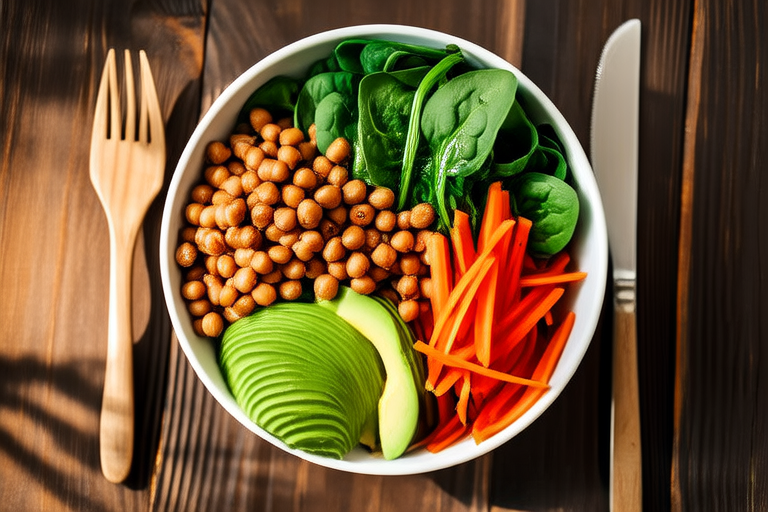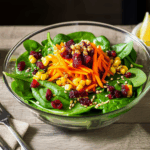- Introduction to Colorful Vegetable Buddha Bowl
A Colorful Vegetable Buddha Bowl is a vibrant and nutritious meal that combines a variety of vegetables, grains, and proteins in one bowl. This dish not only provides a visual feast but also a culinary experience that is both healthy and satisfying. The term “Buddha Bowl” originated from Buddhist cuisine, which emphasizes simplicity, balance, and the use of fresh ingredients. In this article, we will explore how to create a Colorful Vegetable Buddha Bowl that is not only visually appealing but also packed with nutrients.
- Selecting Fresh Ingredients
To ensure your Buddha Bowl is as colorful and flavorful as possible, it’s crucial to select the freshest ingredients available. Start by visiting your local farmers’ market or organic grocery store to gather a diverse selection of vegetables. Choose a mix of root vegetables like carrots, beets, and sweet potatoes for their earthy sweetness and vibrant colors. Add leafy greens such as spinach, kale, and arugula for a nutritional boost and a pop of green. Don’t forget to include bell peppers, zucchini, and tomatoes for their bright hues and crunchy textures. For grains, quinoa, brown rice, or farro are excellent choices as they provide a hearty base while being gluten-free and nutrient-dense.
Proteins can be sourced from plant-based options like tofu, tempeh, or chickpeas, or you can opt for lean meats such as chicken or fish. Avocado slices add creaminess and a rich source of healthy fats, while nuts and seeds like almonds, sunflower seeds, or pumpkin seeds offer crunch and essential minerals. Finally, a variety of herbs and spices, such as cilantro, parsley, cumin, and turmeric, can enhance the flavors and aromas of your Buddha Bowl.
- Preparing the Vegetables
The preparation of vegetables is key to ensuring each bite of your Buddha Bowl is both visually stunning and delicious. Begin by washing all your vegetables thoroughly under cold water to remove any dirt or pesticides. Peel and chop your root vegetables into uniform pieces so they cook evenly. Slice bell peppers and zucchini into strips or half-moons, and dice tomatoes into small cubes. Leafy greens should be rinsed and dried thoroughly before adding them to the bowl. For added texture and flavor, lightly roast or sauté some of your vegetables. Roasting brings out natural sugars, creating a caramelized sweetness, while sautéing allows for the absorption of spices and oils, enhancing their taste.
Consider blanching or steaming certain vegetables like broccoli or green beans to preserve their vibrant colors and crispness. Blanching involves briefly boiling the vegetables in salted water and then plunging them into ice water to stop the cooking process, maintaining their freshness and color. Steaming is another gentle method that preserves nutrients and keeps vegetables tender without overcooking them. By preparing your vegetables using these techniques, you ensure that each component of your Buddha Bowl contributes to its overall appeal and taste.
- Cooking the Grains
Cooking the grains is an essential step in preparing a Colorful Vegetable Buddha Bowl, as it forms the foundation of the dish. When selecting grains, consider their nutritional value and how they complement the other ingredients. Quinoa, a complete protein, is an excellent choice for its versatility and nutty flavor. To cook quinoa, rinse it thoroughly under cold water to remove any bitterness, then combine it with twice its volume of water in a saucepan. Bring the mixture to a boil, reduce the heat to low, cover, and simmer for about 15 minutes until the water is absorbed and the quinoa is fluffy. Fluff with a fork and allow it to cool slightly before incorporating it into your Buddha Bowl.
Brown rice is another nutritious option, offering a chewy texture and subtle sweetness. Rinse the rice under cold water to remove excess starch, then cook it according to package instructions. Typically, two parts water to one part rice is used, bringing it to a boil before reducing the heat and simmering covered for approximately 45 minutes. Once cooked, let the rice sit for a few minutes before fluffing it with a fork. Farro, an ancient grain, adds a heartier texture and deeper flavor. It requires soaking overnight or quick-soaking for about an hour before cooking. After soaking, drain the farro and cook it in a ratio of three parts water to one part farro until tender, usually around 25-30 minutes.
Incorporating grains like quinoa, brown rice, or farro not only enhances the nutritional profile of your Buddha Bowl but also provides a satisfying base for the other ingredients. These grains offer a perfect balance of texture and flavor, making each bite more enjoyable and fulfilling.
- Adding Proteins and Toppings
Adding proteins and toppings to your Colorful Vegetable Buddha Bowl elevates it from a simple meal to a gourmet experience. Plant-based proteins such as tofu, tempeh, or chickpeas are excellent choices for their health benefits and versatility. Tofu can be marinated in soy sauce, sesame oil, and garlic for a savory flavor, then pan-fried until golden brown. Tempeh, a fermented soy product, absorbs marinades well, making it ideal for grilling or sautéing with a variety of spices. Chickpeas, when roasted with olive oil and paprika, become crispy and add a delightful crunch to the bowl.
If you prefer animal-based proteins, consider grilled chicken breast or salmon fillets. Both options can be seasoned with a blend of herbs and spices to enhance their natural flavors. For added texture and flavor, sprinkle on top nuts and seeds like almonds, sunflower seeds, or pumpkin seeds. These toppings not only provide a satisfying crunch but also contribute essential minerals and healthy fats. A drizzle of tahini or peanut sauce can further enrich the dish, adding a creamy element that ties all the flavors together. Lastly, garnish with fresh herbs such as cilantro, parsley, or basil for a burst of freshness and color.
- Serving Suggestions and Storage Tips
When serving your Colorful Vegetable Buddha Bowl, presentation plays a significant role in enhancing the dining experience. Arrange the ingredients artfully within the bowl, layering them to create a visually appealing display. Start with a bed of grains at the bottom, followed by slices of avocado, cubes of tofu or tempeh, and a generous portion of mixed vegetables. Drizzle a light dressing over the top, allowing each component to shine through. For an extra touch, place a sprig of fresh herb or a sprinkle of edible flowers on the side of the bowl.
If you’re preparing the Buddha Bowl ahead of time, proper storage is crucial to maintain its freshness and flavor. Store the grains and vegetables separately in airtight containers in the refrigerator. Reheat the grains gently in a microwave or on the stovetop, and warm up the vegetables if desired. Assemble the bowl just before serving to ensure the best texture and taste. Leftovers can be stored in the fridge for up to three days, but it’s best enjoyed within the first day for optimal freshness.
- Conclusion
A Colorful Vegetable Buddha Bowl is not just a meal; it’s a celebration of vibrant colors, diverse textures, and balanced nutrition. By carefully selecting fresh ingredients, preparing vegetables with care, cooking grains to perfection, and adding a variety of proteins and toppings, you can create a Buddha Bowl that is both visually stunning and delicious. Whether enjoyed as a solo meal or shared with loved ones, this dish offers a wholesome and satisfying dining experience that caters to various dietary preferences. Embrace the art of crafting a Buddha Bowl and savor each bite of this colorful, nutritious masterpiece.

